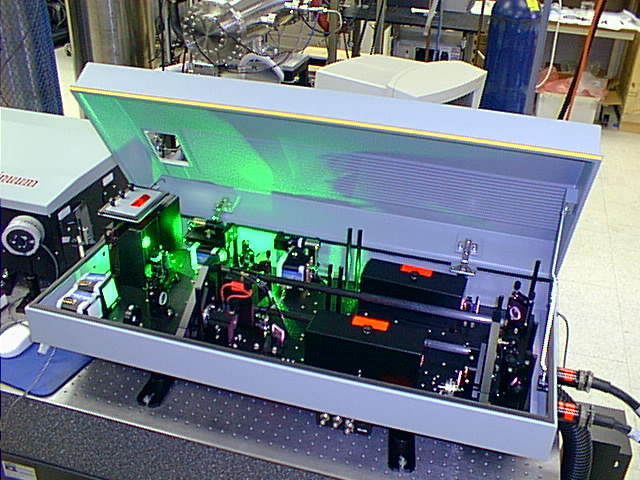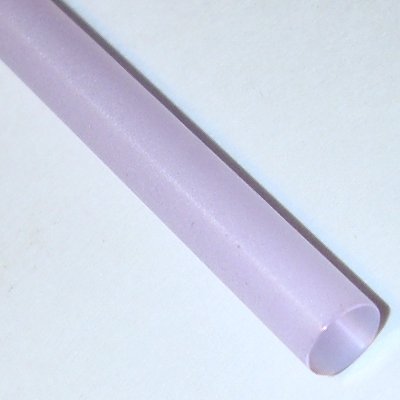|
Nd-YAG
Nd:YAG (neodymium-doped yttrium aluminum garnet; Nd:Y3Al5O12) is a crystal that is used as a lasing medium for solid-state lasers. The dopant, triply ionized neodymium, Nd(III), typically replaces a small fraction (1%) of the yttrium ions in the host crystal structure of the yttrium aluminum garnet (YAG), since the two ions are of similar size.Koechner §2.3, pp. 48–53. It is the neodymium ion which provides the lasing activity in the crystal, in the same fashion as red chromium ion in ruby lasers. Laser operation of Nd:YAG was first demonstrated by J.E. Geusic ''et al.'' at Bell Laboratories in 1964. Technology Nd: YAG lasers are optically pumped using a flashtube or laser diodes. These are one of the most common types of laser, and are used for many different applications. Nd:YAG lasers typically emit light with a wavelength of 1064 nm, in the infrared. However, there are also transitions near 946, 1120, 1320, and 1440 nm. Nd:YAG lasers operate in both ... [...More Info...] [...Related Items...] OR: [Wikipedia] [Google] [Baidu] |
Yttrium Aluminium Garnet
Yttrium aluminium garnet (YAG, Y3 Al5 O12) is a synthetic crystalline material of the garnet group. It is a cubic yttrium aluminium oxide phase, with other examples being YAlO3 (YAP) in a hexagonal or an orthorhombic, perovskite-like form, and the monoclinic Y4Al2O9 (YAM). Due to its broad optical transparency, low internal stress, high hardness, chemical and heat resistance, YAG is used for a variety of optics. Its lack of birefringence (unlike sapphire) makes it an interesting material for high-energy/high-power laser systems. Laser damage levels of YAG ranged from 1.1 to 2.2 kJ/cm² (1064 nm, 10 ns). YAG, like garnet and sapphire, has no uses as a laser medium when pure. However, after being doped with an appropriate ion, YAG is commonly used as a host material in various solid-state lasers. Rare earth elements such as neodymium and erbium can be doped into YAG as active laser ions, yielding Nd:YAG and Er:YAG lasers, respectively. Cerium-doped YAG (Ce:YA ... [...More Info...] [...Related Items...] OR: [Wikipedia] [Google] [Baidu] |
Yttrium Aluminum Garnet
Yttrium aluminium garnet (YAG, Y3 Al5 O12) is a synthetic crystalline material of the garnet group. It is a cubic yttrium aluminium oxide phase, with other examples being YAlO3 (YAP) in a hexagonal or an orthorhombic, perovskite-like form, and the monoclinic Y4Al2O9 (YAM). Due to its broad optical transparency, low internal stress, high hardness, chemical and heat resistance, YAG is used for a variety of optics. Its lack of birefringence (unlike sapphire) makes it an interesting material for high-energy/high-power laser systems. Laser damage levels of YAG ranged from 1.1 to 2.2 kJ/cm² (1064 nm, 10 ns). YAG, like garnet and sapphire, has no uses as a laser medium when pure. However, after being doped with an appropriate ion, YAG is commonly used as a host material in various solid-state lasers. Rare earth elements such as neodymium and erbium can be doped into YAG as active laser ions, yielding Nd:YAG and Er:YAG lasers, respectively. Cerium-doped YAG (Ce:YAG ... [...More Info...] [...Related Items...] OR: [Wikipedia] [Google] [Baidu] |
Q-switching
Q-switching, sometimes known as giant pulse formation or Q-spoiling, is a technique by which a laser can be made to produce a pulsed output beam. The technique allows the production of light pulses with extremely high (gigawatt) peak power, much higher than would be produced by the same laser if it were operating in a continuous wave (constant output) mode. Compared to modelocking, another technique for pulse generation with lasers, Q-switching leads to much lower pulse repetition rates, much higher pulse energies, and much longer pulse durations. The two techniques are sometimes applied together. Q-switching was first proposed in 1958 by Gordon Gould, p. 93. and independently discovered and demonstrated in 1961 or 1962 by R.W. Hellwarth and F.J. McClung at Hughes Research Laboratories using electrically switched Kerr cell shutters in a ruby laser. Optical nonlinearities such as Q-switching were fully explained by Nicolaas Bloembergen, who won the Nobel prize in 1981 for this ... [...More Info...] [...Related Items...] OR: [Wikipedia] [Google] [Baidu] |
Infrared
Infrared (IR), sometimes called infrared light, is electromagnetic radiation (EMR) with wavelengths longer than those of visible light. It is therefore invisible to the human eye. IR is generally understood to encompass wavelengths from around 1 millimeter (300 GHz) to the nominal red edge of the visible spectrum, around 700 nanometers (430 THz). Longer IR wavelengths (30 μm-100 μm) are sometimes included as part of the terahertz radiation range. Almost all black-body radiation from objects near room temperature is at infrared wavelengths. As a form of electromagnetic radiation, IR propagates energy and momentum, exerts radiation pressure, and has properties corresponding to both those of a wave and of a particle, the photon. It was long known that fires emit invisible heat; in 1681 the pioneering experimenter Edme Mariotte showed that glass, though transparent to sunlight, obstructed radiant heat. In 1800 the astronomer Sir William Herschel ... [...More Info...] [...Related Items...] OR: [Wikipedia] [Google] [Baidu] |
Gas Discharge Lamp
Gas-discharge lamps are a family of artificial light sources that generate light by sending an electric discharge through an ionized gas, a plasma. Typically, such lamps use a noble gas (argon, neon, krypton, and xenon) or a mixture of these gases. Some include additional substances, like mercury, sodium, and metal halides, which are vaporized during startup to become part of the gas mixture. Single ended self-starting lamps are insulated with a mica disc and contained in a borosilicate glass gas discharge tube (arc tube) and a metal cap. They include the sodium-vapor lamp that is the gas-discharge lamp in street lighting. In operation, some of the electrons are forced to leave the atoms of the gas near the anode by the electric field applied between the two electrodes, leaving these atoms positively ionized. The free electrons thus released flow onto the anode, while the cations thus formed are accelerated by the electric field and flow towards the cathode. Typically, ... [...More Info...] [...Related Items...] OR: [Wikipedia] [Google] [Baidu] |
Glass
Glass is a non-Crystallinity, crystalline, often transparency and translucency, transparent, amorphous solid that has widespread practical, technological, and decorative use in, for example, window panes, tableware, and optics. Glass is most often formed by rapid cooling (quenching) of the Melting, molten form; some glasses such as volcanic glass are naturally occurring. The most familiar, and historically the oldest, types of manufactured glass are "silicate glasses" based on the chemical compound silicon dioxide, silica (silicon dioxide, or quartz), the primary constituent of sand. Soda–lime glass, containing around 70% silica, accounts for around 90% of manufactured glass. The term ''glass'', in popular usage, is often used to refer only to this type of material, although silica-free glasses often have desirable properties for applications in modern communications technology. Some objects, such as drinking glasses and glasses, eyeglasses, are so commonly made of silicate- ... [...More Info...] [...Related Items...] OR: [Wikipedia] [Google] [Baidu] |
Yttrium Orthovanadate
Yttrium orthovanadate (YVO4) is a transparent crystal. Undoped YVO4 is also used to make efficient high-power polarizing prisms similar to Glan–Taylor prisms. There are two principal applications for doped Yttrium orthovanadate: *Doped with neodymium it forms Nd:YVO4, an active laser medium used in diode-pumped solid-state lasers. *Doped with europium it forms Eu:YVO4, the dominant red phosphor used in cathode ray tubes especially in color TVs. Basic properties *Crystal structure: **Zircon tetragonal (tetragonal bipyramidal) ** Space group D4h ** Lattice parameters ''a'' = ''b'' = 7.119 Å, ''c'' = 6.290 Å *Density: 4.24 g/cm3 *Melting point: 1810–1940 °C *Mohs hardness: glass-like, ~5 * Knoop hardness: 480 kg/mm2 * Thermal expansion coefficient: ** αa = 4.43×10−6/ K ** αc = 11.37×10−6/K *Thermal conductivity coefficient: **parallel to ''c''-axis: 5.23 W·m−1·K−1 **perpendicular to ''c''-axis: 5.10 W·m−1·K−1 * Refractive indices, bi ... [...More Info...] [...Related Items...] OR: [Wikipedia] [Google] [Baidu] |
Yttrium Lithium Fluoride
Yttrium lithium fluoride (LiYF4, sometimes abbreviated YLF) is a birefringent crystal, typically doped with neodymium or praseodymium and used as a gain medium in solid-state lasers. Yttrium is the substitutional element in LiYF4. The hardness of YLF is significantly lower than other commons crystalline laser media, i.e. yttrium aluminium garnet Yttrium aluminium garnet (YAG, Y3 Al5 O12) is a synthetic crystalline material of the garnet group. It is a cubic yttrium aluminium oxide phase, with other examples being YAlO3 (YAP) in a hexagonal or an orthorhombic, perovskite-like form, and t .... References See also * Neodymium-doped yttrium lithium fluoride Optical materials Crystals Yttrium compounds Lithium compounds Fluorides Metal halides {{crystal-stub ... [...More Info...] [...Related Items...] OR: [Wikipedia] [Google] [Baidu] |
Continuous Wave
A continuous wave or continuous waveform (CW) is an electromagnetic wave of constant amplitude and frequency, typically a sine wave, that for mathematical analysis is considered to be of infinite duration. It may refer to e.g. a laser or particle accelerator having a continuous output, as opposed to a pulsed output. Continuous wave is also the name given to an early method of radio transmission, in which a sinusoidal carrier wave is switched on and off. Information is carried in the varying duration of the on and off periods of the signal, for example by Morse code in early radio. In early wireless telegraphy radio transmission, CW waves were also known as "undamped waves", to distinguish this method from damped wave signals produced by earlier '' spark gap'' type transmitters. Radio Transmissions before CW Very early radio transmitters used a spark gap to produce radio-frequency oscillations in the transmitting antenna. The signals produced by these spark-gap tr ... [...More Info...] [...Related Items...] OR: [Wikipedia] [Google] [Baidu] |
Xenon
Xenon is a chemical element with the symbol Xe and atomic number 54. It is a dense, colorless, odorless noble gas found in Earth's atmosphere in trace amounts. Although generally unreactive, it can undergo a few chemical reactions such as the formation of xenon hexafluoroplatinate, the first noble gas compound to be synthesized. Xenon is used in flash lamps and arc lamps, and as a general anesthetic. The first excimer laser design used a xenon dimer molecule (Xe2) as the lasing medium, and the earliest laser designs used xenon flash lamps as pumps. Xenon is also used to search for hypothetical weakly interacting massive particles and as a propellant for ion thrusters in spacecraft. Naturally occurring xenon consists of seven stable isotopes and two long-lived radioactive isotopes. More than 40 unstable xenon isotopes undergo radioactive decay, and the isotope ratios of xenon are an important tool for studying the early history of the Solar System. Radioactive xen ... [...More Info...] [...Related Items...] OR: [Wikipedia] [Google] [Baidu] |
Krypton
Krypton (from grc, κρυπτός, translit=kryptos 'the hidden one') is a chemical element with the symbol Kr and atomic number 36. It is a colorless, odorless, tasteless noble gas that occurs in trace amounts in the atmosphere and is often used with other rare gases in fluorescent lamps. With rare exceptions, krypton is chemically inert. Krypton, like the other noble gases, is used in lighting and photography. Krypton light has many spectral lines, and krypton plasma is useful in bright, high-powered gas lasers (krypton ion and excimer lasers), each of which resonates and amplifies a single spectral line. Krypton fluoride also makes a useful laser medium. From 1960 to 1983, the official definition of meter was based on the wavelength of one spectral line of krypton-86, because of the high power and relative ease of operation of krypton discharge tubes. History Krypton was discovered in Britain in 1898 by William Ramsay, a Scottish chemist, and Morris Travers, a ... [...More Info...] [...Related Items...] OR: [Wikipedia] [Google] [Baidu] |


.jpg)




